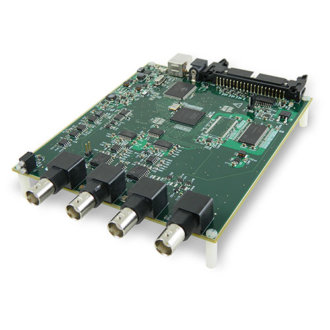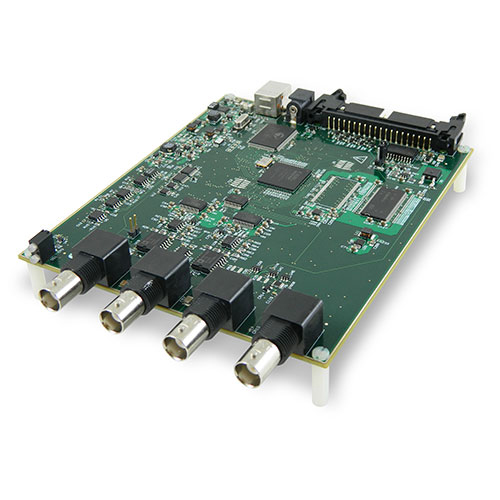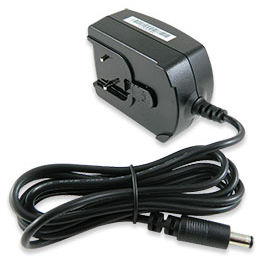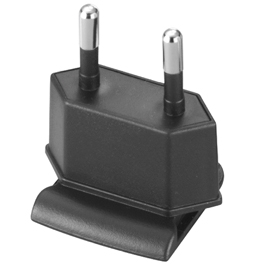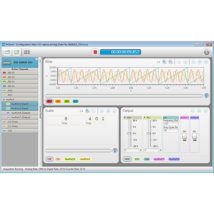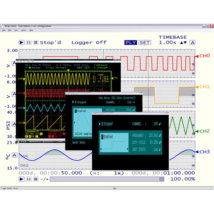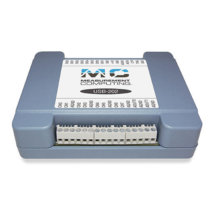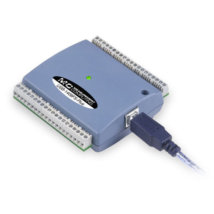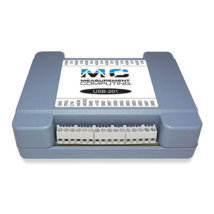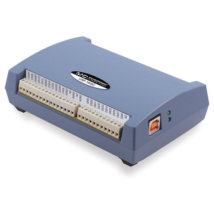| USB-2020 | Ultra high-speed, simultaneous sampling USB DAQ board with 2 SE A/D, 20 MS/s, 8 DIO. Includes US PSU | |
| USB-2020-PSU-EU | Europe PSU for USB-2020 |
USB-2020 - 12-Bit, 20 MS/s, Simultaneous Sampling, Ultra High-Speed USB Board
- Two 20 MS/s analog inputs
– Simultaneous sampling
– 1 A/D per channel
– 12-bit resolution
– ±10 V, ±5 V, ±2 V, ±1 V voltage ranges (software-selectable)
– 17 MHz input bandwidth - 64 megasample onboard memory
– 40 MS/s overall rate to onboard memory when acquiring from both channels
– 8 MS/s throughput to host computer - Analog and digital triggering
– Level and edge - Analog and digital gating
- Internal or external pacing of analog scans
- Eight digital I/O
- BNC connectors and 40-pin auxiliary connector for signal connections
- Includes USB cable, power supply (required), and nylon standoffs
- Small, compact design (7.1” x 5.6”) for OEM and embedded applications
Summary
The USB-2020 is a high-speed two-channel data acquisition board that provides simultaneous sampling at rates up to 20 MS/s per channel. Users can sample data from both channels at an overall rate of 40 MS/s to the 64 megasample onboard memory, or continuously stream data to a host computer at up to 8 MS/s for one or both channels over a high-speed USB connection.
Each channel has its own A/D converter for simultaneous sampling to eliminate channel skew and ensure phase information between channels is maintained.
Flexible triggering and gating ensures data is acquired when needed. The clock I/O input allows acquisitions to be controlled by the onboard clock or by an external clock source for applications that require user-supplied pacing.
The board provides signal connections through four standard BNC connectors and a 40-pin auxiliary connector.
The CB-PWR-9 power supply (included), provides the 9 VDC power to the USB-2020.
Analog Input Acquisition Modes
The USB-2020 can acquire analog data using BURSTIO or continuous scan mode.
BURSTIO
BURSTIO enables a device to acquire data at higher rates than are supported by the USB data transfer rate.
In BURSTIO, the USB-2020 can sample data to onboard memory at rates up to 20 MS/s per channel.
Because each channel has its own A/D converter, an overall sample rate of 40 MS/s is achieved when sampling both channels. The simultaneous sampling eliminates channel skew and maintains phase coherence between the two channels.
The memory buffer can store up to 64 megasamples at the maximum rate for transfer to the computer after the acquisition is complete.
Continuous Scan Mode
Continuous scan mode enables data to be directly transferred to the host computer during acquisition. The maximum rate in continuous scan mode is 8 MS/s for all acquired data (one channel or two channels). The maximum rate achieved depends on the host computer.
External Clock I/O
USB-2020 analog input scanning operations can be paced with the internal A/D clock or with an external clock source.
The CLK IO connector can be configured through software for input (default) for external pacing, or for output to pace a connected device.
Trigger Input
The USB-2020 supports digital and analog triggers and gates, and each type has software-selectable configurations.
Digital triggers can be configured for rising or falling edge, or for high or low level.
Analog triggers can be configured for above or below software-selectable level, or for rising or falling edge with software-selectable hysteresis.
Digital gates can be configured for high or low level.
Analog gates can be configured for software-selectable high or low level, or for in or out of software-selectable window.
An analog scan can have a trigger or a gate, but not both. For example, an analog trigger cannot be used at the same time as the TRIG IN BNC connector is being used to gate.
Digital I/O
The USB-2020 provides eight digital I/O lines on the 40-pin auxiliary connector. When a bit is configured for input, it can detect the state of any TTL-level input.
Each DIO channel is an open-drain, which can sink up to 150 mA for direct drive applications when used as an output.
External Pull-Up Capability
Digital inputs are pulled high by default to 5 V through 47 kohm resistors on the circuit board. The pull-up voltage is common to all 47 kohm resistors. The pull-up/pull-down state can be changed from a header on the board.
An external pull-up resistor can also be used to pull the DIO bit up to a voltage that exceeds the internal 5 V pull-up voltage (15 V maximum).
BNC and 40-Pin Auxiliary Connectors
The USB-2020 provides four standard BNC connectors for both analog inputs, trigger input, and clock I/O. Use standard BNC cables to connect the BNC female connectors.
The board also includes a 40-pin auxiliary connector for the eight digital I/O, two 5 V power outputs, and an alternate trigger input connection. The signals available from the 40-pin auxiliary connector require a separately-purchased cable.
INCLUDED SOFTWARE
- TracerDAQ® for acquiring and displaying data and generating signals
- InstaCalTM software utility for installing, configuration, and testing
- Universal Library includes support for Visual Studio® and Visual Studio®.NET, including examples for Visual C++®, Visual C#®, and Visual Basic®.NET
- ULx for NI LabVIEWTM Library of VIs and example programs to speed your NI LabVIEW development
- Linux® Support for MCC DAQ products
- Python™ Support for MCC DAQ Products
OPTIONAL SOFTWARE
- DAQamiTM – data acquisition companion software for acquiring data and generating signals
- TracerDAQ®Pro – Out-of-the-box virtual instrument suite with strip chart, oscilloscope, function generator, and rate generator – professional version
- MATLAB® Support for MCC Products – Software Environment for Data Acquisition, Data Analysis, and Application Development

